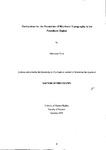Mechanisms for the Formation of Rhythmic Topography in the Nearshore Region
| dc.contributor.author | Coco, Giovanni | |
| dc.contributor.other | School of Biological and Marine Sciences | en_US |
| dc.date.accessioned | 2013-09-17T09:34:28Z | |
| dc.date.available | 2013-09-17T09:34:28Z | |
| dc.date.issued | 1999 | |
| dc.identifier | NOT AVAILABLE | en_US |
| dc.identifier.uri | http://hdl.handle.net/10026.1/1775 | |
| dc.description.abstract |
The possibility that the periodic features observed in the nearshore region are the result of self-organisational processes is investigated in this work. The behaviour of two numerical models, based on different techniques, has been analysed in order to describe the formation of periodic features in the surf and swash zone respectively. The appearance of periodic patterns in the nearshore region has been traditionally linked to the presence of standing edge waves with the topographic changes passively driven by the flow patterns. A more recent approach indicates the possibility that periodic patterns appear because of feedback processes between beach morphology and flow. In the first model, the coupling between topographic irregularities and wave driven mean water motion in the surf zone is examined. This coupling occurs due to the fact that the topographic perturbations produce excess gradients in the wave radiation stress that cause a steady circulation. To investigate this mechanism, the linearised stability problem in the case of an originally plane sloping beach and normal wave incidence is solved. It is shown that the basic topography can be unstable with respect to two different modes: a giant cusp pattern with shore attached transverse bars that extend across the whole surf zone and a crescentic pattern with alternate shoals and pools at both sides of the breaking line showing a mirroring effect. For the swash zone, the formation of beach cusps has been investigated. The several theories proposed in the past have been analysed and all the field and laboratory measurements available in the literature collected in order to test such theories. It is suggested that, with the available measurements it is not possible to distinguish between the standing edge wave model and the self-organisation approach. A numerical model based on self-organisation has been here developed and tested in order to understand the processes occurring during beach cusp formation and development, to evaluate the sensitivity towards the parameters used and to look at how the model might relate to field observations. Results obtained confirm the validity of the self-organisation approach and its capacity to predict beach cusp spacing with values in fair agreement with the available field measurements and with most of the input parameters primarily affecting the rate of the process rather than the final spacing. However, changes in the random seed and runs for large numbers of swash cycles reveal a dynamical system with significant unpredictable behaviour. A qualitative comparison between the model results and field measurements collected by Masselink et al. (1997) during beach cusp formation and development has also been performed on the basis of a non-linear fractal technique. Results indicate beach locations and time-scales where non-linearities are more important and self-organisation can play a fundamental role. | en_US |
| dc.language.iso | en | en_US |
| dc.publisher | University of Plymouth | en_US |
| dc.title | Mechanisms for the Formation of Rhythmic Topography in the Nearshore Region | en_US |
| dc.type | Thesis | |
| plymouth.version | Full version | en_US |
| dc.identifier.doi | http://dx.doi.org/10.24382/4505 | |
| dc.identifier.doi | http://dx.doi.org/10.24382/4505 |
Files in this item
This item appears in the following Collection(s)
-
01 Research Theses Main Collection
Research Theses Main


